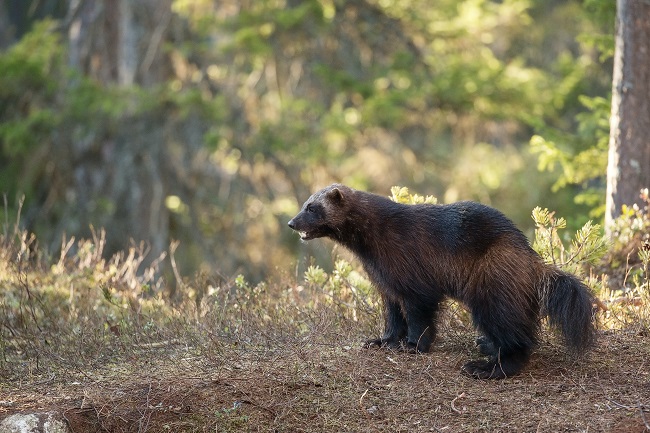
The wolverine (Gulo gulo) also referred to as the glutton, carcajou, or quickhatch, is the largest land-dwelling species of the family Mustelidae and is a creature that embodies both mystery and ferocity. Despite its small stature, this elusive member of the weasel family has captured the imaginations of humans for centuries. Known for its strength, resilience, and solitary nature, the wolverine has become an icon of wilderness, embodying the untamed spirit of the wild.
Characteristics
The wolverine is a compact mammal, resembling a small bear. It possesses a stocky build, short legs, and a bushy tail. Weighing between 20 and 55 pounds, wolverines are remarkably strong for their size. They possess sharp, non-retractable claws and powerful jaws that aid in hunting and scavenging.
One of the most distinctive features of the wolverine is its fur, which varies in color from dark brown to black, often with light-colored facial markings. This dense fur provides excellent insulation during the frigid winters of their habitat.
Habitat and Distribution
Wolverines are found primarily in the boreal forests and tundra regions of North America, Europe, and Asia. They are highly adaptable creatures, able to thrive in a range of ecosystems, from snowy alpine mountains to dense forests. These elusive animals require large home ranges due to their solitary nature and their need to scavenge over vast areas to find food.
Behavior and Adaptations
Wolverines are known for their resourcefulness and ability to endure harsh conditions. They possess numerous adaptations that enable them to survive in their challenging environments. With their large, snowshoe-like paws, wolverines can travel easily across deep snow, and their strong sense of smell helps them locate food buried beneath the surface.
Wolverines are opportunistic predators and scavengers, feeding on a wide range of prey, including small mammals, birds, eggs, fish, carrion, berries, and even insects. Their incredibly strong jaws allow them to crush bones, enabling them to access the marrow inside. These scavenging habits have earned them the reputation of being nature’s cleanup crew.
One of the wolverine’s most fascinating behaviors is its ability to cache food for later consumption. Wolverines have been observed burying carcasses under the snow, marking the location with scent markings. They can return to these hidden caches weeks or months later, even after heavy snowfall, displaying remarkable spatial memory and navigational skills.
Conservation Status
Despite their formidable nature, wolverines face numerous challenges, including habitat loss and fragmentation. They are listed as a species of concern in many countries and have disappeared from several regions where they once thrived. Wolverines are slow to reproduce, with females giving birth to a small litter of two to three kits every two to three years. This slow reproductive rate makes them vulnerable to population decline. Furthermore, their dependence on large, undisturbed areas for hunting and denning exacerbates their conservation challenges.
Conservation efforts are underway to protect wolverines and their habitats. Scientists and wildlife organizations are studying their behavior, monitoring populations, and advocating for increased protection. Understanding the ecological importance of wolverines as top predators and indicators of ecosystem health is crucial for their long-term survival.
12 Fun Facts About Wolverines
Ferocious Reputation
Wolverines are known for their fierce nature and tenacity. Despite their small size, they are incredibly strong and have been observed taking down prey much larger than themselves.
Size and Appearance
Wolverines are compact animals, measuring about 26 to 42 inches in length, excluding the tail, which adds an additional 7 to 10 inches. They typically weigh between 20 and 55 pounds.
Incredible Strength
Wolverines have one of the strongest bites relative to their size among mammals. Their jaws are specially adapted to crush bones, allowing them to access the nutritious marrow inside.
Wide Distribution
Wolverines have a broad distribution across the northern regions of North America, Europe, and Asia. They are found in countries such as Canada, Alaska, Norway, Russia, and Mongolia.
Adaptations for Snowy Environments
Wolverines thrive in cold and snowy habitats. Their large, snowshoe-like paws help them move efficiently over deep snow, while their thick fur provides insulation against the cold.
Solo Wanderers
Wolverines are solitary animals, preferring to roam alone over vast territories. Males have been known to cover territories as large as 250 to 500 square miles.
Scent Markings and Communication
Wolverines communicate with each other through scent markings. They use their anal glands to release a pungent odor, which helps them mark territories and locate potential mates.
Powerful Noses
Wolverines possess a keen sense of smell, which they use to locate prey and find buried food sources. Their sense of smell is so acute that they can detect carrion buried beneath several feet of snow.
Expert Climbers
Wolverines are skilled climbers and are known to scale steep slopes and trees with ease. Their agility allows them to navigate their rugged habitats effectively.
Olympic Swimmers
Wolverines are proficient swimmers and can cross large bodies of water with ease. They use their powerful limbs and buoyant bodies to navigate rivers and lakes.
Curiosity and Playfulness
Wolverines are known to be curious and playful animals, often engaging in activities such as sliding down snowy slopes or engaging in mock fights.
Elusive Sightings
Due to their solitary nature and vast territories, wolverines are challenging to spot in the wild. They are incredibly elusive and prefer to avoid human presence.
Related Articles & Free Email Newsletter Sign Up
Bobcats Range from Southern Canada to Northern Mexico
Giant Salamanders are the Largest Amphibians in the World


Comment here